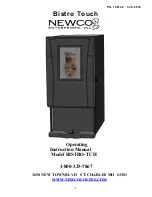
EasyLoad System
1
INTRODUCTION TO THE EasyLoad
TM
and EasyLift
TM
SYSTEMS
Unique to Ifor Williams the factory fitted EasyLoad
TM
ramp and EasyLift
TM
barrier system
greatly simplifies the loading of the upper deck without the need to manhandle ramps or
livestock.
With the deck system folded away the trailer is suitable for use with cattle and other livestock.
In this configuration the EasyLoad
TM
ramp is used in the same manner as a conventional
loading ramp.
All deck and rear barrier components are stored on board the trailer and are conveniently
and safely stowed for quick and easy access. When required the deck system can be
deployed or stowed within a few minutes without the need for any tools or special equipment.
With the decks deployed the EasyLoad
TM
ramp can be operated, lifting easily into position,
assisted by way of two gas springs, requiring very little effort from the operator.
The EasyLift
TM
rear barrier automatically tilts the last section of decking down, so that the
deck, barrier and ramp all fit together to form one single loading ramp with a reduced incline
1
.
Once loading is complete the mechanism of the EasyLift
TM
rear barrier can be used to lift the
rear deck section back into place and then by utilising the weight of the operator the
EasyLoad
TM
inner ramp can be lowered and simply locked in place.
BEFORE LOADING / UNLOADING
Whenever loading and unloading, the trailer MUST be attached to the towing vehicle
The trailer should be positioned on firm and reasonably level ground, if the trailer is on soft
or uneven ground it may be necessary to provide additional support under the ramp feet
(which contact the ground when the ramp is opened) to keep them level or to prevent them
from sinking into the ground.
Before commencing any loading or unloading operations, the operator should be aware of
general health and safety issues, taking particular care to avoid any actions which may pose
a risk to passers by, or other road users.
OPENING THE OUTER RAMP
The ramp is held closed by two rotating handles, these in turn are
locked by spring loaded plungers to provide positive ramp
locking.
To release, depress the plunger and rotate the handle away from
the ramp. As it opens the handle crosses the path of the plunger
thus holding it in. Repeat this operation for the other side.
With both catches released, stand to one side and carefully lower
the ramp to the ground.
Users of trailers should still exercise caution and follow general
health and safety practices when operating any ramp or door, to
avoid injury to themselves, other people or animals present.
Ramp assistor springs fitted to the outer ramp and gas springs
fitted to the inner ramp should be checked on a regular basis, if
in doubt consult your local Ifor Williams Distributor.
1. As specified in (EC) No 1/2005 on the protection of animals during transport and related operations.
RAMP HANDLE






















